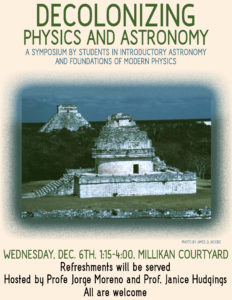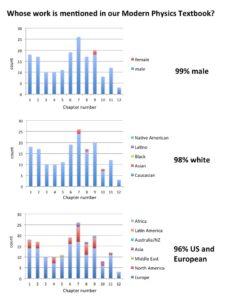Physics is a deeply human activity, reflecting both the richness and the biases that we scientists bring to it.
Curricular focus: The role of bias and privilege in physics: empowering change
In my Modern Physics course (Fall 2017-2019), we looked through our (entirely standard and widely used) textbook and came to the shocking realization that of the physicists whose work is presented in the book, 99% are men and 98% are white.
This led to us examining the effects of bias and privilege in physics and in our classroom: Who gets to participate? Whose work gets noticed? And what role does each of us play in perpetuating this? We ended the semester by finding ways to make positive change in the areas that most interested each student, and showcased our work, together with an astronomy class, in a public, community-building celebration of Decolonizing Physics and Astronomy.
In my Modern Physics class, we address these questions in a series of reading and reflection assignments, lightly edited for clarity below.
-
Assignment 1: Whose work is included in our textbook?
Since this is a modern physics course, we’re going to think a bit about who gets included in the accepted canon of “modern physics,” why, and what impact that has on our field. If you’ve looked at the TV monitor outside my office or looked at my website (specifically, https://research.pomona.edu/janice-hudgings/teaching/broadening-the-canon/), you’ll have some idea of where I’m going with this. Last year, I asked everyone to sketch out her/his own timeline of modern physics, and then we looked at the breakdown of who is included in that canon; you can see a summary of the results at the website given above.
This year, let’s try something different and instead look at who is included in our textbook. So, in the table on the next page, I’ve assigned each of you a chapter of our textbook. Please skim through your chapter, and make a list of all the people mentioned in the chapter. Then look each person up online and note down, if you can find the info, her/his gender, ethnicity, and what country s/he is from (or was from at the time of her/his most important contribution). Flawed though they are, let’s use the federal government’s classifications of race and ethnicity.
So, based on our collective analysis of our textbook (which is pretty representative of modern physics textbooks in general), modern physics is traditionally taught through a very narrow lens, largely omitting contributions by women, people of color, and nationalities outside of Europe and North America.
Please do a little reading/investigating on this topic and then reflect briefly – a short paragraph is fine – on why the modern physics canon looks like it does. If you’re looking for inspiration, the writing of Dr. Chanda Prescod-Weinstein on decolonizing science is fascinating. Or check out #ILookLikeAnEngineer. There are lots of other possible resources as well; please list for me at the bottom what you read or viewed on this topic. You don’t have to go overboard; 2-3 resources are fine here.
Also, note that although I’ve suggested a couple of resources with particular points of view, the question about “why” is a vast one, with many possible answers. I am not looking for a specific “right answer” from you, but rather a thoughtful answer to my question.
-
Assignment 3: Implicit bias
In the last homework, we sketched out some initial thoughts about why the modern physics canon focuses so narrowly on the work of white men. Let’s spend the next few homeworks digging deeper on a couple of topics. First up: implicit bias.
- Please take at least two Implicit Association Tests (IAT) at https://implicit.harvard.edu/implicit/takeatest.html. I’d like you to at least take the “Black-White” and “Gender-Science” tests, but if you have the stamina for more, there are some other interesting looking ones. In addition to thinking about your own results, please think about the average results that are presented at the end.
- Then please read the article titled “Driving Campus Diversity One Decision at a Time,” which is posted on Sakai. I’d like you to pay particular attention to the sections “Why address implicit bias in higher education” and “Combating the influence of implicit biases.” But read this after you take the IATs yourself; the article is much more compelling with that information in hand!
Finally, please write a short (one or two paragraphs) reflection on the average results of the IATs and the article. Some food for thought to get you started: How pervasive are these implicit biases? How are they distinct from or intertwined with explicit bias and institutionalized bias? How might implicit biases (again, distinct from explicit or institutionalized bias) affect your classes or life at Pomona in general? Can you identify some examples not mentioned in the reading? Does implicit bias play a role in explaining the lack of representation of women and people of color in physics? And what are some ideas for how to mitigate those biases, either your own or more generally? You don’t need to answer every one of these questions; they’re just meant as thought-provokers.
(Note that I am not asking you what your results are, and I’m also not asking for a critique of the test itself. If you’re curious about the Implicit Association Test’s limitations, there’s a whole literature out there on carefully constructed experiments.)
-
Assignment 4: Stereotype Threat
Last week, we thought about the effects of implicit bias. This week, let’s look at another pressure: stereotype threat. Please read the article “A Threat in the Air: How Stereotypes Shape Intellectual Identity and Performance,” by Claude Steele. Dr. Steele is famous for his extensive work in this field, and you can find dozens of articles on this topic written by Dr. Steele and his students. Optionally, you might also want to watch the YouTube video “Stereotype Threat: A Conversation with Claude Steele,” but don’t let that replace reading the article!
The article I’ve assigned is long, alas – I chose it because it is the most complete summary of his work that I can find, and it does a great job of explaining the nuances of the argument, along with summarizing some really compelling research studies. Since the paper is long, consider the following questions, to help focus your reading:
- What precisely is stereotype threat, and how does it differ from implicit bias, self-doubt, and explicit biases such as socioeconomic and educational discrimination, which also can affect educational success? The paper repeatedly makes the point that stereotype threat is NOT referring to the idea that negative stereotypes impair women and/or people of color’s academic performance by triggering self-doubt about their own abilities – so, what then is stereotype threat?
- Beyond the two examples of stereotype threat that Dr. Steele is discussing in his paper, what are some other examples of stereotype threat?
- What are the main experiments that Dr. Steele’s research group did to test their ideas about stereotype threat?
- Optional: Since this paper was written in 1997, Dr. Steele and his students have done extensive research on interventions to reduce stereotype threat. If this intrigues you, try looking at some of Geoffrey Cohen’s work.
Once you’ve had a chance to think about this paper a bit, please write a brief reflection. The questions above might make a good starting point, but I’d also like you to think a bit about how these ideas relate to your experiences at Pomona. Is stereotype threat “in the air” here as well? What impacts does it have locally?
-
Assignment 5: Micro and Macro -aggressions
This week, let’s focus on microaggressions, which happen constantly, in the classroom, on campus, in the world at large, whether we notice them or not. There’s a huge range of info out there on this, so please pick a couple of the resources below to explore and then do a little digging on your own.
First, please read at least one of the articles listed below. These articles give a brief explanation of the taxonomy of microaggressions, as well as some physics-specific examples.
- The article “Understanding Women’s Gendered Experiences in Physics and Astronomy Through Microaggressions,” which is on Sakai under the shorter filename “microaggressions women in physics.” This article is alas pretty dispassionate, but it’s the one really physics-student-specific article I could find.
- The article at: https://phys.org/news/2015-11-small-microaggressions-big.html. From the context, I think this article is written by a physicist, but it’s a little unclear.
Then, please check out at least one of the following:
- http://itooamharvard.tumblr.com This is a really interesting project by Harvard students. Check out the video at the top and then scroll down through pages and pages of #itooamharvard images, many of which illustrate microaggressions.
- Try looking up “microaggressions” on google images to get a whole range of examples.
Finally, if you still have some time, try poking around online for other examples. In particular, I focused on women in physics and on black college students in the links above, but microaggressions happen along lots of different lines. There is a universe of discouraging examples out there.
As usual, I’d like for you to write a brief reflection on what you’ve learned from the above resources. Here are some questions to get you started, which you can choose to answer all or part of:
- Do the examples given in these resources sound familiar? Can you give an example of each of the three types of microaggressions that you’ve heard here at Pomona? How about in the department? Or, ouch, in our class? In hindsight, are there ways in which you wish you had responded differently or intervened?
- Or, more painfully, what are some ways in which you have committed microaggressions? (Face it, we have all done it along one axis or more, painful though that is.) What did you do at the time to repair the damage? What do you wish you’d done?
- One of the readings quotes someone saying “Can you imagine trying to take an exam with all that going on?” – so, really, what is that like? (If you don’t know, imagine it. If you do know through firsthand experience, you are welcome to describe it if you want to.)
I’ve heard microaggressions described as “death by a thousand papercuts.” What does that mean? What are the potential effects of experiencing these insults day after day? (And I do want to make the caveat here that I don’t think these things are actually papercuts. They damage us, each and every one of them.) It would be interesting to answer that question twice: what is the potential cumulative effect on the target of the microaggressions, and what is the potential cumulative effect on the “majority audience,” who hear these microaggressions day after day?
-
Assignment 6: Structural and Institutional Racism
This week, let’s look at the effects – here at Pomona, in our classrooms – of structural racism (sometimes called systemic racism) and its close ally, institutional racism. The Aspen Institute offers the following definitions[1]:
Structural Racism: A system in which public policies, institutional practices, cultural representations, and other norms work in various, often reinforcing ways to perpetuate
racial group inequity. It identifies dimensions of our history and culture that have allowed
privileges associated with “whiteness” and disadvantages associated with “color” to endure and adapt over time. Structural racism is not something that a few people or institutions choose to practice. Instead it has been a feature of the social, economic and political systems in which we all exist.
Institutional Racism: Institutional racism refers to the policies and practices within and across institutions that, intentionally or not, produce outcomes that chronically favor, or put a racial group at a disadvantage. Poignant examples of institutional racism can be found in school disciplinary policies in which students of color are punished at much higher rates that their white counterparts, in the criminal justice system, and within many employment sectors in which day-to-day operations, as well as hiring and firing practices can significantly disadvantage workers of color.
To get at least a first pass idea of what structural racism is about, please watch the video here: https://kottke.org/17/06/systematic-racism-in-america-explained-in-just-three-minutes
Next, please read “10 Signs of Institutionalized Racism and the Rhetoric of Greatness,” a Huffington Post article[2] that sketches some of the ways in which institutional racism plays out in higher education. This article seems to be mostly written with an audience of college faculty or administrators in mind, but you can imagine how to translate that to student experience.
Can you come up with a similar list of 10-signs-of-institutional-bias-at-Pomona? Notice that I broadened the conversation here to bias in general, so while your 10-signs list should definitely include institutionalized racism, it could also encompass other forms of institutionalized bias. I would like you to focus on concrete examples that directly affect the experiences of you and your physics classmates here at Pomona, rather than on more abstract or distant examples, so please at least start by thinking about our Physics and Astronomy Department.
[1] https://assets.aspeninstitute.org/content/uploads/files/content/docs/rcc/RCC-Structural-Racism-Glossary.pdf
[2]
I had trouble getting a clean pdf of this article, so please just google the title to find it online.
-
Assignment 7: White Privilege
Please read “White Privilege: Unpacking the Invisible Knapsack,” by Peggy McIntosh, which is posted on Sakai.
Let’s start by thinking briefly about the term “white privilege,” which is often seen by (white) people as an insult. However, I think it’s more useful to think of this as a statement of fact, one that is not intended as an insult but rather as a description of reality – what do I mean by that? What other forms of privilege exist in physics and astronomy? And why is the author talking about an “invisible knapsack?” (Responding to the questions in this paragraph in writing is optional, but please do at least think about them.)
Once you’ve read the article and thought about the above paragraph, please consider your knapsack, particularly in regard to your role as a physics and astronomy student here at Pomona. What’s in your knapsack, thinking broadly about a variety of forms of privilege? Please see if you can list at least 10 items in your knapsack that are directly relevant to you as a phys/astro student. And you could always go on more broadly from there if you’re interested in this exercise, although that’s optional.
-
Assignment 8: Empowering change
Over the past six or seven weeks, we’ve been thinking about the culture of physics and astronomy, along with the roles implicit bias, stereotype threat, microaggressions, institutional bias, and our own privilege play in the Physics and Astronomy Department here at Pomona, as well as more broadly. I’d like to use this week’s homework to reflect a bit on those readings and to think about how to improve the climate in the department.
So, I’d like you to do three things:
- Please look back over the previous Homework Part III readings and your responses and remind yourself of what each of those was about. Then please write a brief (one paragraph is fine) reflection on what are to you the main take-away lessons of the Part III assignments we’ve done so far. I’m looking less for a summary of the readings here and more for a reflection on what you personally got from these readings.
- Please brainstorm a short list (3 or more items is good) of small changes an individual could make in her/his behavior/style/approach to improve the climate or to mitigate some of the biases we read about. As usual, I’m looking for concrete ideas that are immediately relevant to us, here in our phys/astro classrooms or in the department more generally. You might try thinking about this from two perspectives: what do I wish my classmates (or professors!) would change, and what could I change about my own approach? Here I’m just asking for “small” everyday things. For example: She could stop saying “Hey, guys!” all the time; I could share the air more; etc…
- As I’ve alluded to a few times in class, I’m going to eventually ask you to work in small teams (2-3 people) on a project on the topic of inclusivity and/or social justice in physics and astronomy. To give you time to work on them, we’ll replace the usual Part III assignments with these projects for the last month or so of class. On the last day of classes (Wednesday, Dec 6, 1:15-4), we’ll join with the Astro 1 class for a “poster” session in the Millikan courtyard; “poster” is in quotes because I’m open on the format of your contribution.
For now, I’d like you to brainstorm a few ideas of potential projects you would be interested in working on. You’re eventually only going to work on one project and are not committing here to any of these ideas; the goal here is just to brainstorm. I’ve listed a few ideas below to get you started. You’re welcome to include some of those ideas in your list, but please include at least one idea of your own as well. As usual, I’m looking for project ideas that address – here, locally in the department – the issues of climate, bias, and privilege that we’ve been talking about. What are some things that you’d enjoy working on and would make a difference in the department?
-
Assignments 9-13: Decolonizing Physics and Astronomy projects
The students spent the next four weeks working on their projects, including writing formal project proposals, positionality statements, and weekly progress updates.
-
Final day of class
On the last day of class, we had a community-wide celebration, our Decolonizing Physics and Astronomy Symposium, in which the students in my class and in a colleague’s astronomy class showcased their projects, consumed a remarkable quantity of pan dulce and horchata, and generally had a terrific time bonding as a community.


